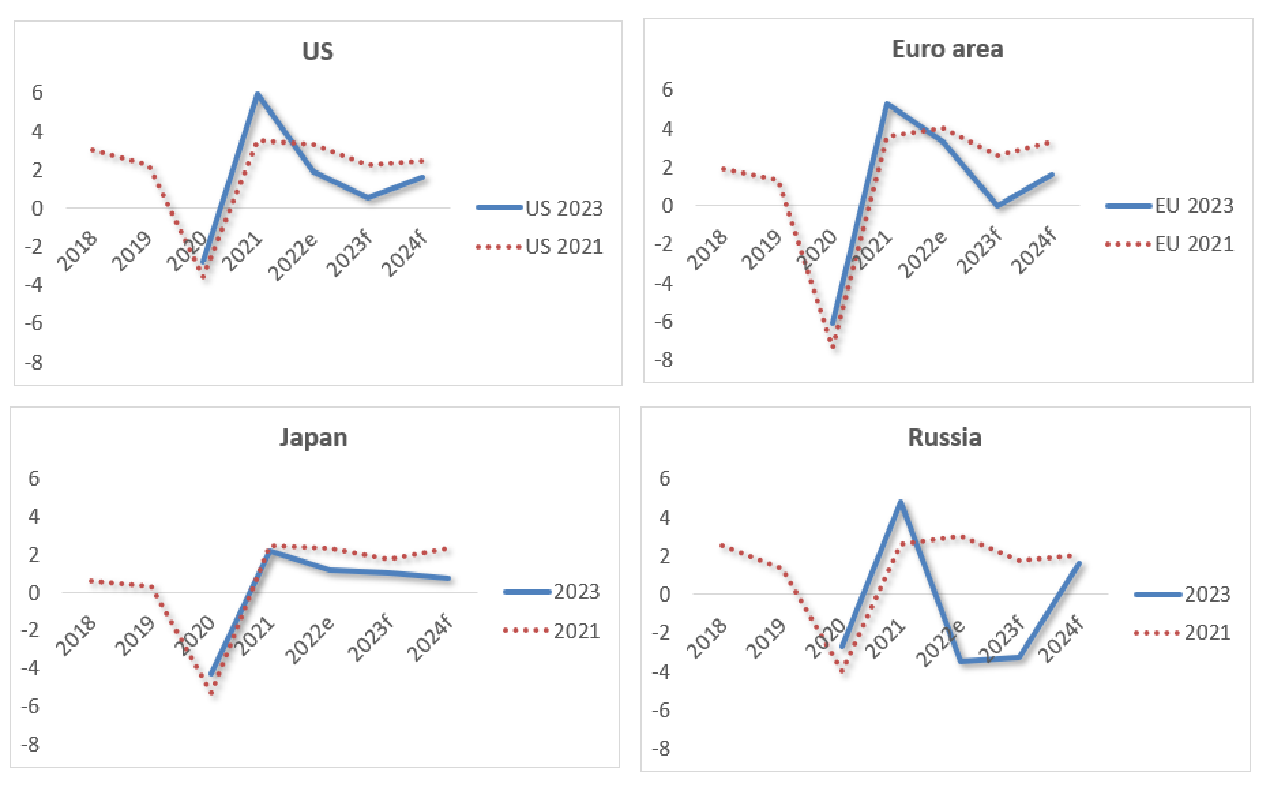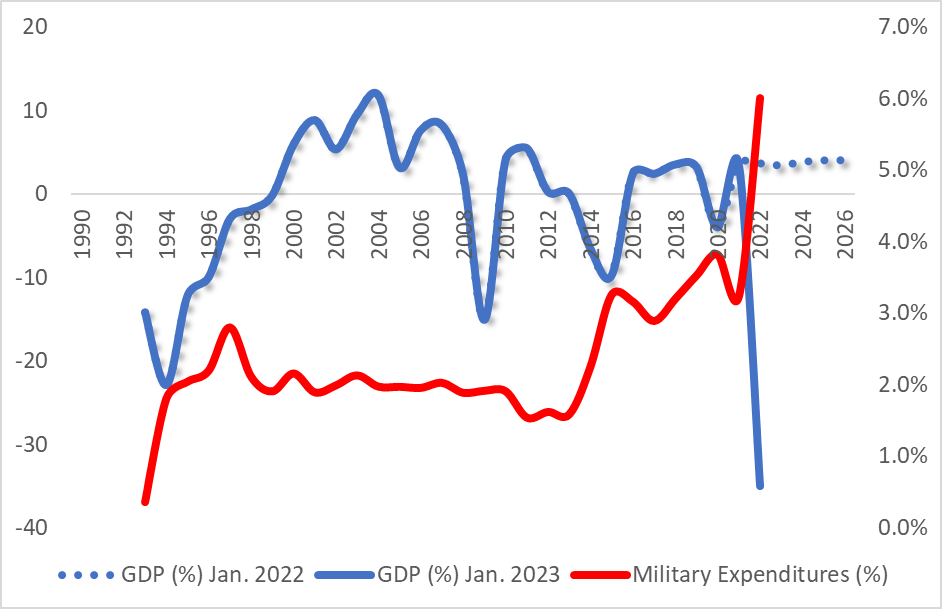A year ago, I characterized the U.S./NATO-led proxy war in Ukraine as “the unwarranted war.” I predicted that this was an “avoidable war that will penalize severely Ukraine, Russia, the U.S., and the NATO, Europe, developing countries, and the global economy.”
In contrast to those who expected a fast triumph, irrespective of the beneficiaries, mine was a contrarian call for peace and neutrality. Today, those predictions have proved valid, as I show in a new analysis, “the unwarranted Ukraine proxy war – a year later.”
Following a year of economic and human devastation, it is time to pose hard counterfactual questions. Now that we have a clearer idea of what has happened, it is easier to conjecture on what might have happened. It is the difference between the two – the missed opportunities – that may penalize global economic prospects for years to come, or worse.
Plunging growth in the West
Global growth is now expected to decelerate sharply to 1.7 percent in 2023. That’s the third weakest pace of growth in nearly three decades. One way to quantify these adverse shocks is to compare consensus growth estimates before the Ukraine conflict and today (Figure 1).
Figure 1 The costs of the proxy war in major economies

Data from Global Economic Prospects, World Bank, Jan. 2021 and 2023. Trend growth, based on the 2021 data, has been projected up to 2024 (round dots in red). The difference between the two charts reflects the missed opportunities. (Source: World Bank; Difference Group)
Overall, U.S. growth for 2022 slowed to 1.9 percent as substantial fiscal consolidation - worth about 5 percent of GDP - added to monetary headwinds. Growth is projected to slow to recession level in 2023. That’s over 2 percentage points below previous forecasts and the weakest performance outside official recessions since 1970. In 2022-23 alone, the war is contributing to a loss of 1-2 percentage points of U.S. GDP growth per year. In the $25 trillion economy, that means up to $250 to $500 billion.
Estimated at 1.2 percent of GDP in 2022 and up to 2 percent of GDP in 2023, fiscal measures were introduced by European governments to soften the impact of energy price increases. In 2023, growth is forecast to contract, which means a downward revision of over 2 percentage points. In Japan, growth is expected to slow further to 1 percent in 2023. According to the Bank of Japan (BOJ), 53 percent of people surveyed admitted their wealth had slumped last year. Worse, the BOJ has doubled its inflation forecast for the coming year.
In Russia's $2.1 trillion economy, the war means 5 to 6 percentage points in lost GDP growth. While the math is distressing, Russians believe a NATO Ukraine would have pushed their country back to a ‘90s style nightmare. To derail Russia's resilience, the U.S. and NATO are preparing for a multiyear proxy war, despite its destructive impact worldwide.
In 2023, the ray of hope in this dire global landscape is China’s reopening. It could offset a decline in other emerging and developing economies. That, however, is predicated on continued easing in U.S.-Sino relations, which is no longer assured.
Ukrainian nightmare
Even as international media was touting the mirage of Ukraine’s military triumph, the country's real GDP declined over 35 percent on an annual basis in the third quarter of 2022; that is, before Russia's massive infrastructure attack.
Starting on October 10, Russia's waves of missile and drone attacks opened a new phase of the war. The direct physical damage to infrastructure soared to $127 billion already in September; that’s over 60 percent of Ukraine’s pre-war GDP. The impact on the productive capacity of key sectors is substantial and long-lasting.
Poverty will increase from 5.5 percent in 2021 to 25 percent in 2022. As casualties continue to mount, over a third of the population has been displaced and over half of all Ukrainian children have been forced to leave their homes. As of October 2022, the number of Ukrainian refugees in Europe was over 7.8 million, and the number of internally displaced people was 6.5 million.
As former Pentagon adviser Col. (ret.) Douglas Macgregor has argued, "Washington’s refusal to acknowledge Russia’s legitimate security interests in Ukraine and negotiate an end to this war is the path to protracted conflict and human suffering."
Development versus war
In 2019, China bypassed Russia as Ukraine’s biggest single trading partner. In 2020, Kyiv and Beijing signed a deal to strengthen cooperation in multiple areas, particularly in infrastructure financing and construction. A year later, overall trade boomed to $19 billion, having soared 80 percent since 2013.
To President Zelensky, the BRI meant an alternative future that would be more peaceful and stable. Or as he said to President Xi Jinping, Ukraine could become a “bridge to Europe” for Chinese investments.
Nonetheless, Washington had worked three decades to transform Ukraine into a client state, in order to destabilize Russia. Peace and development had no role in these plans.
From 1991 to 2014, the U.S. provided Ukraine with $4 billion in military assistance, even though it is not a NATO member. By 2021, over $2.7 billion was added, plus over a $1 billion provided by the NATO Trust Fund, which is only a part of the total military investments in Ukraine.
The Biden administration favored the idea of another major U.S. military base, right at the Kremlin’s backdoor, as a platform for operations. As a common enemy, Russia could “make America united again.”
The $1 trillion mirage
In 2014, Ukrainian military spending was about 3 percent of GDP, increasing to 6 percent in 2022, corresponding to more than $11 billion. In brief, Ukrainian military expenditures have doubled since the 2014 regime ploy. Meanwhile, its economic growth has tanked. Instead of the expected 3.7 percent in 2022, it plunged dramatically some 35 percent (Figure 2).
Figure 2 Ukraine’s economic growth and military expenditures, 1990-2026

Source: Data from SIPRI, IMF; Difference Group, Mar. 5, 2022, Jan. 2023
This estimate, of course, is far, far too optimistic because it does not include the full war funding, of which the U.S. provides over 60 percent. The international total of over $110 billion accounts for more than half of Ukraine’s pre-war GDP ($200 billion). Effectively, these funding arrangements aim to sustain the hostilities and destruction not just in 2023, but at least until the late 2020’s. A scenario the West's recent arms sales escalation seems to reinforce.
What’s ahead in 2023 will be worse. Reconstruction will require a lot more than $1 trillion. Ukraine as it is known has ceased to exist. The costs will mortgage Ukrainians to the third generation.
Why was peace derailed?
As historian Geoffrey Roberts has argued, President “Putin went to war to prevent Ukraine from becoming an ever-stronger and threatening NATO bridgehead on Russia’s borders.”
The war was not the Ukrainians’ first choice either. When President Zelenskyy, whom Ukrainians elected as a “peace candidate,” flirted with the idea of reconciliation with Russia in 2019, Ukraine's notorious far-right torpedoed it.
Even in April 2022, after a month of hostilities, Russia and Ukraine tentatively agreed to end the war. But that decision was undermined by former British Prime Minister Boris Johnson. Peace talks were not acceptable to the U.S. and some of its allies.
Ironically, it was only a year ago that Ukraine was still positioned to embrace neutrality, opt out from military alignments and serve as a bridge between Eastern and Western Europe, and China. If that future had prevailed, Ukraine would be peaceful today. Its GDP would be a third bigger and expanding faster than in years. Instead of 150,000 killed and injured soldiers, young men would be alive and well and have good jobs. Ukrainian refugees would be returning home. Children wouldn’t suffer from traumatic nightmares.
The U.S./NATO-led proxy war in Ukraine is aimed against Russia. The Ukrainians’ role is to die in it. It is an unwarranted war. It was avoidable. It didn’t have to happen. And any escalation will only make a terrifying status quo far worse.
